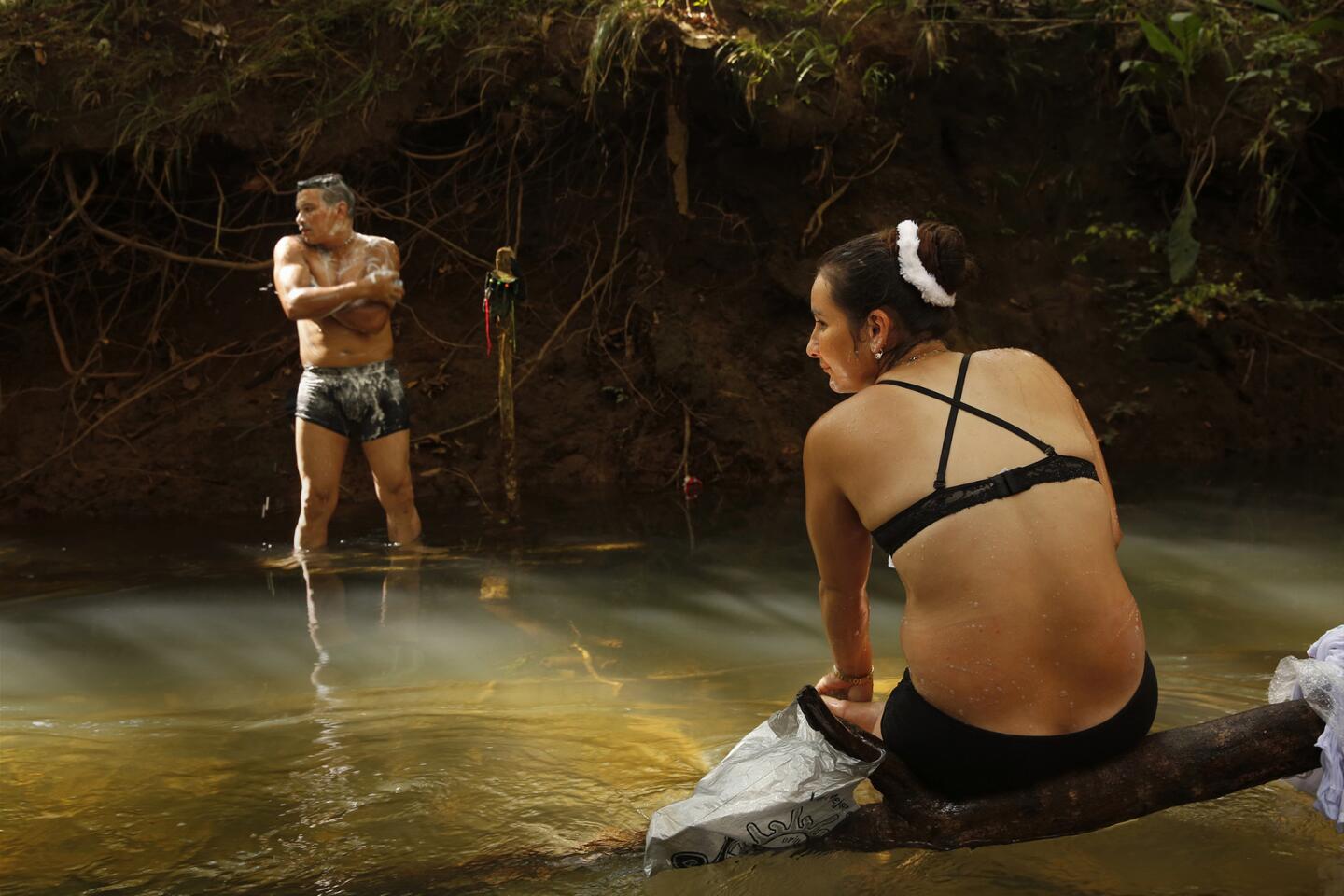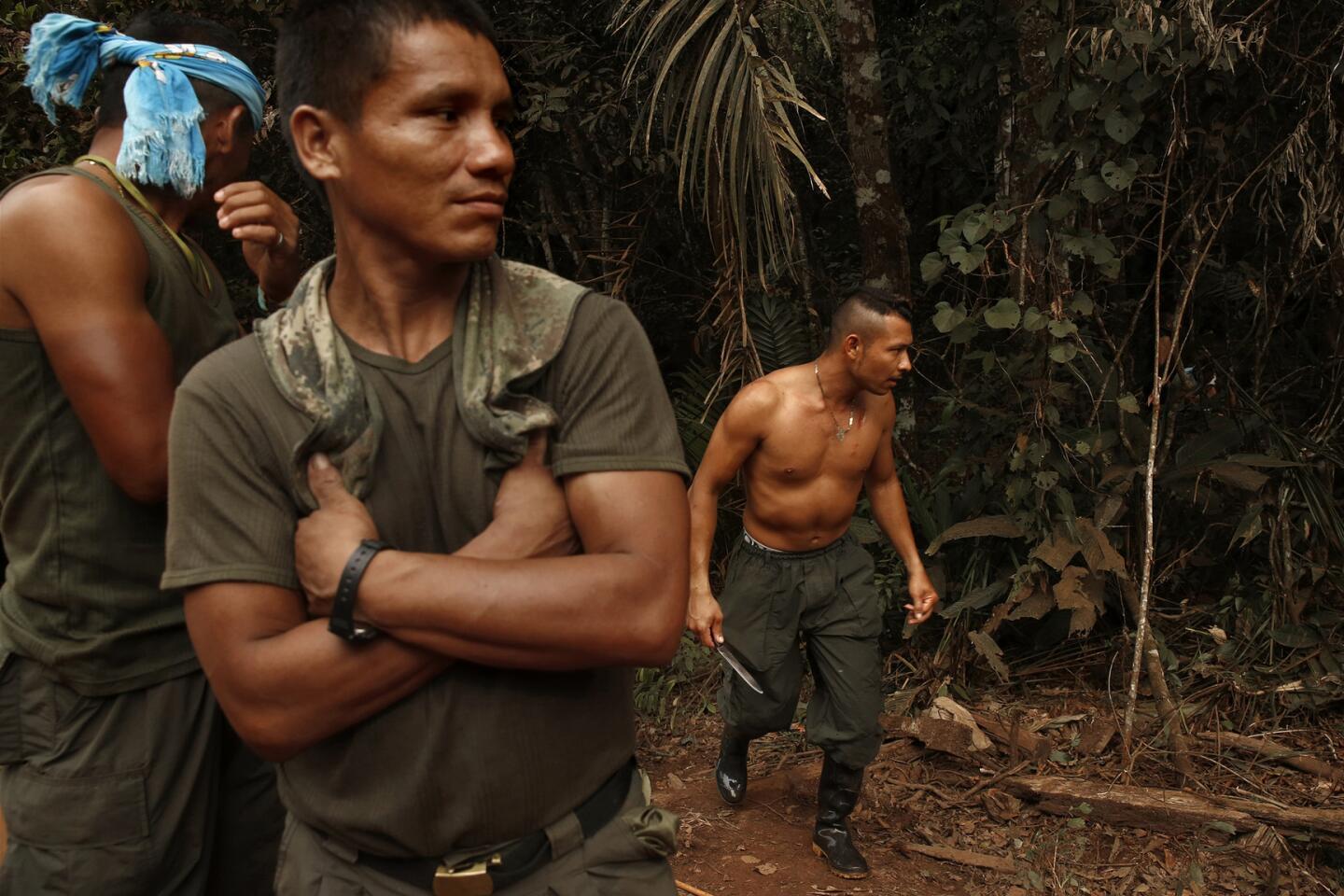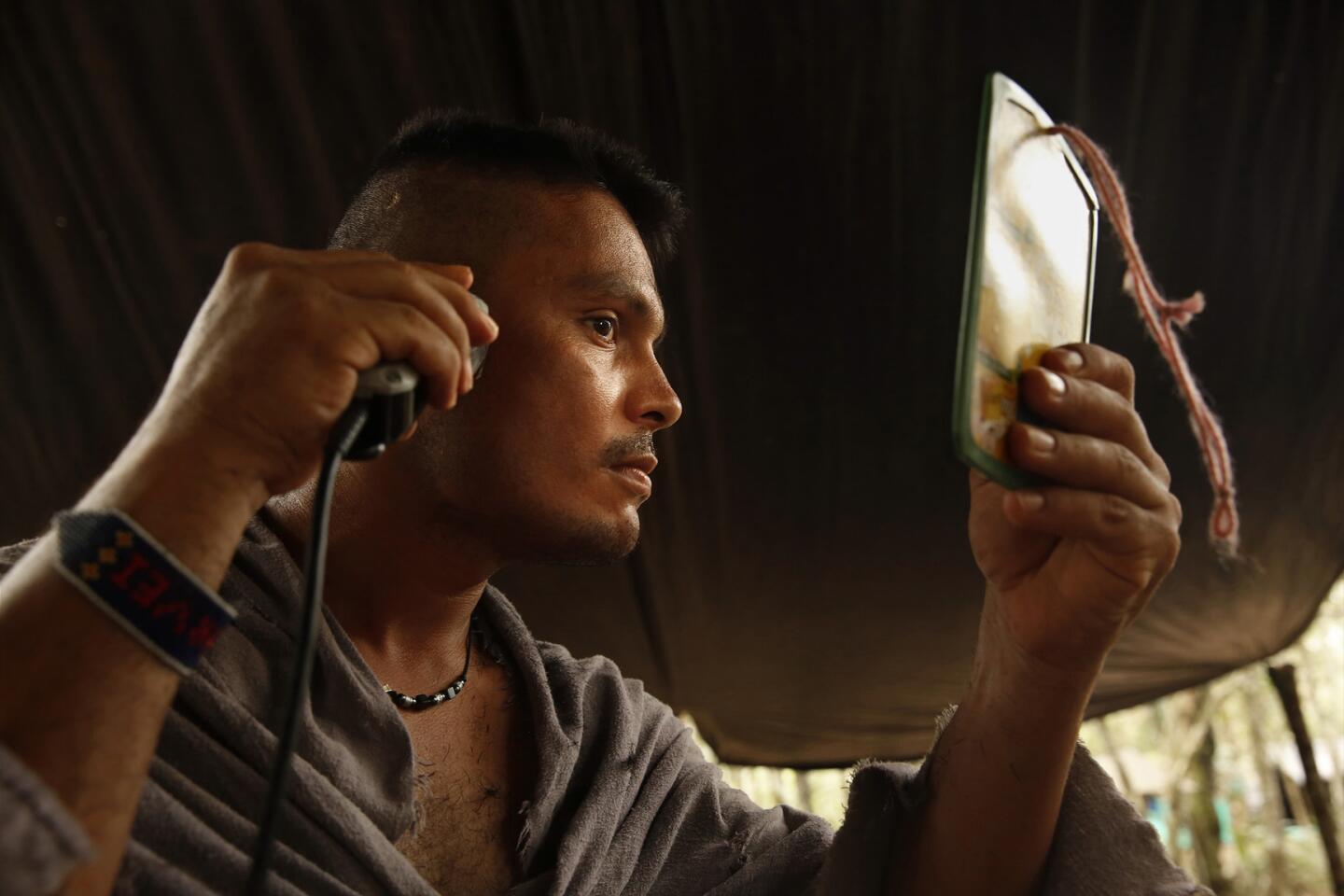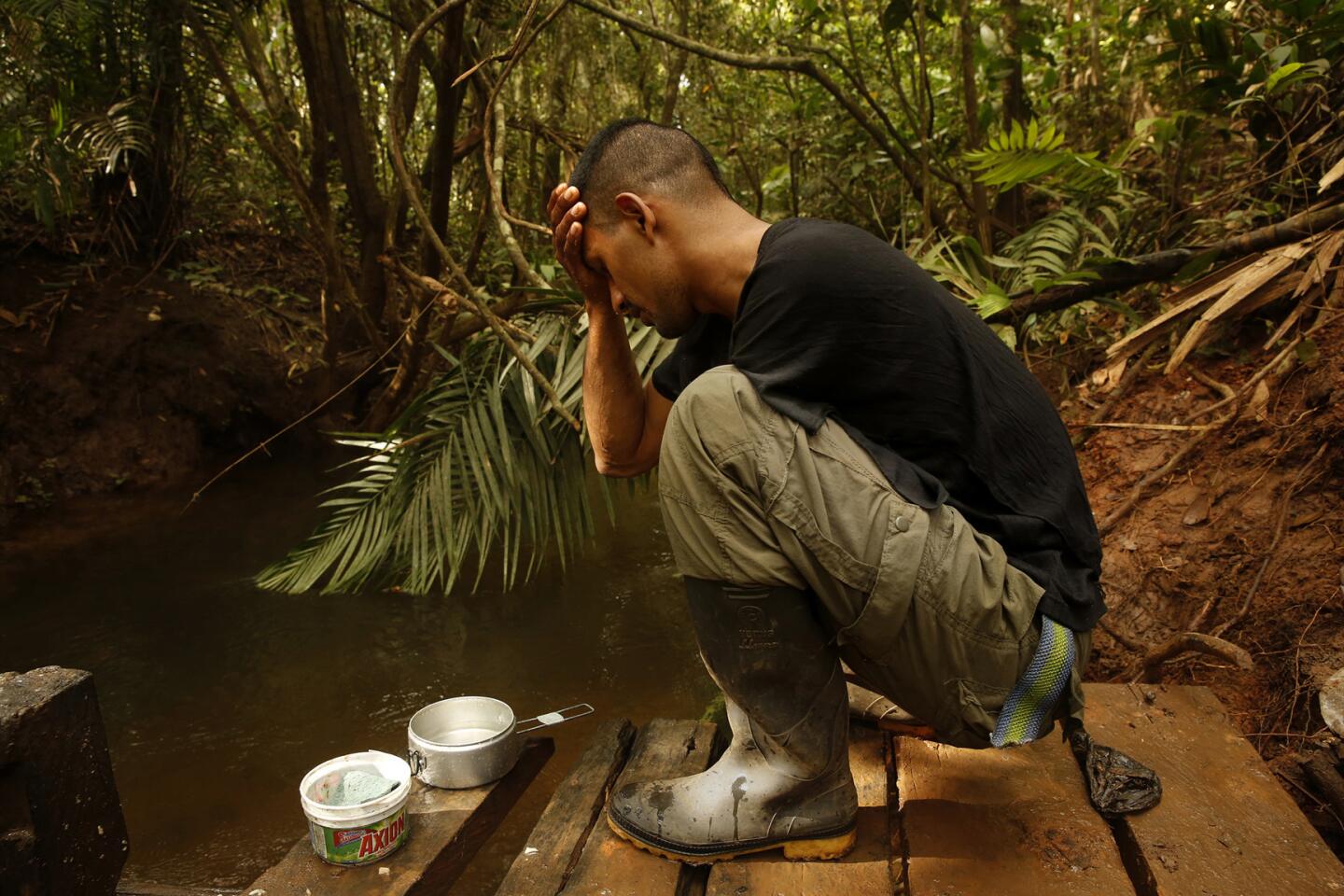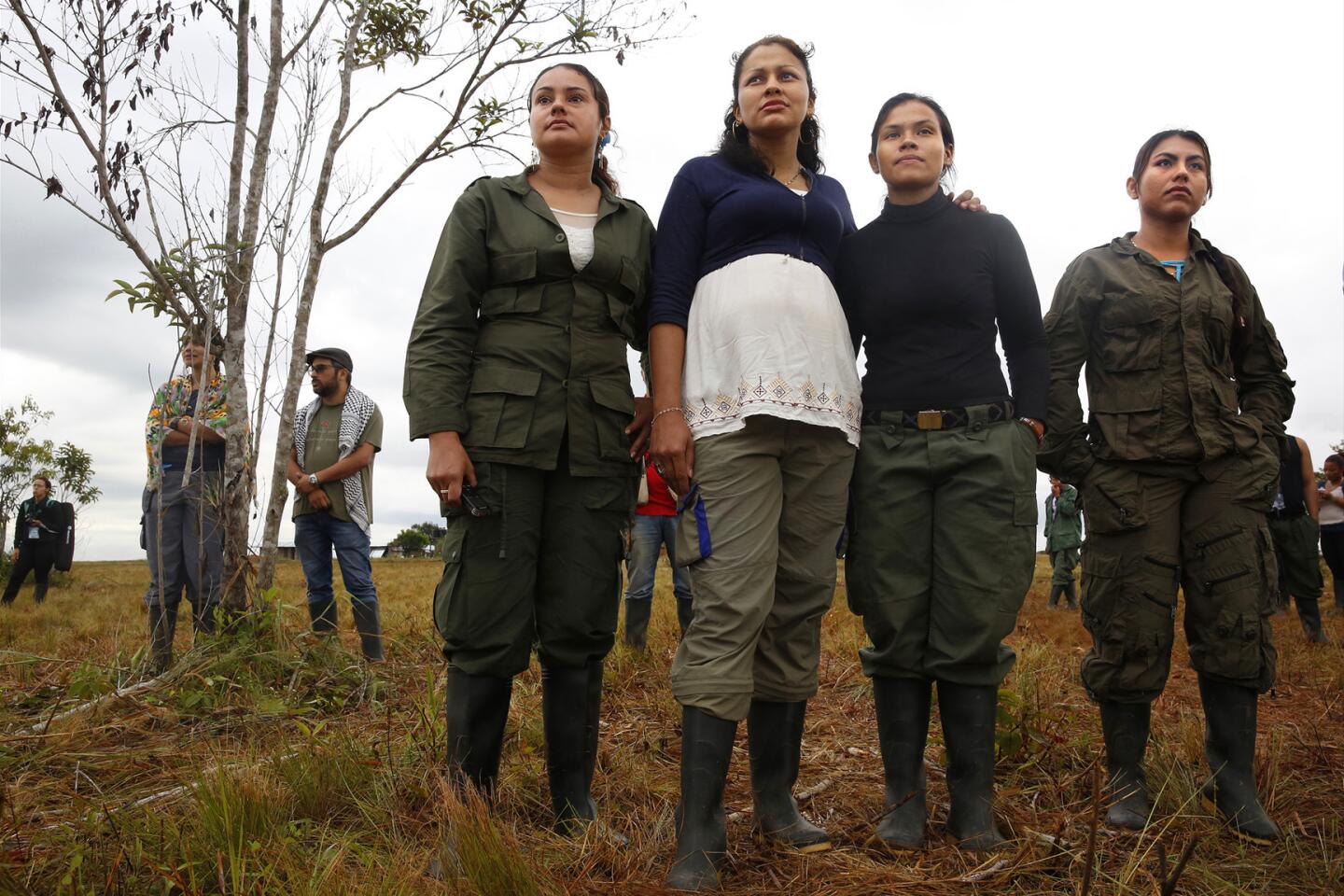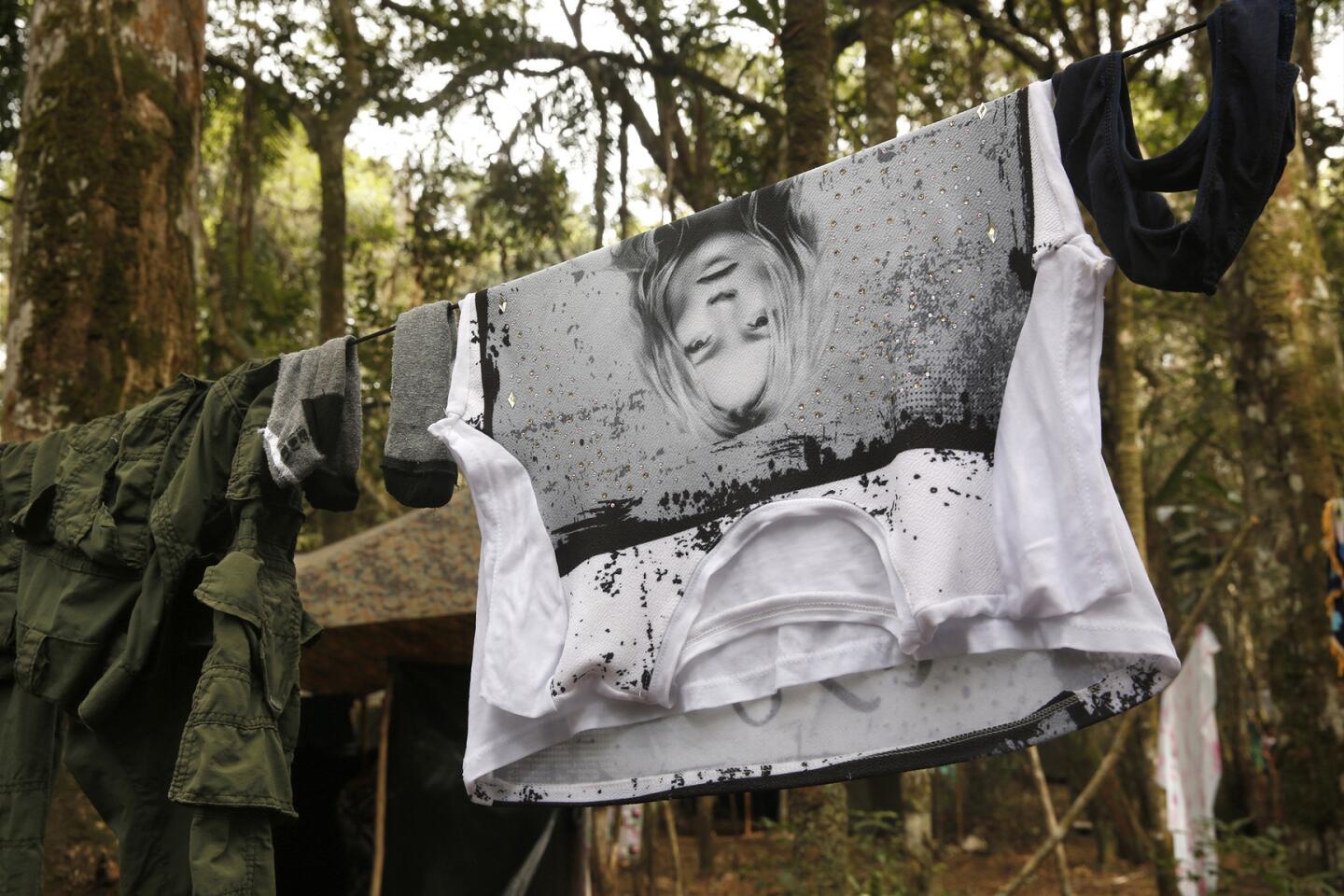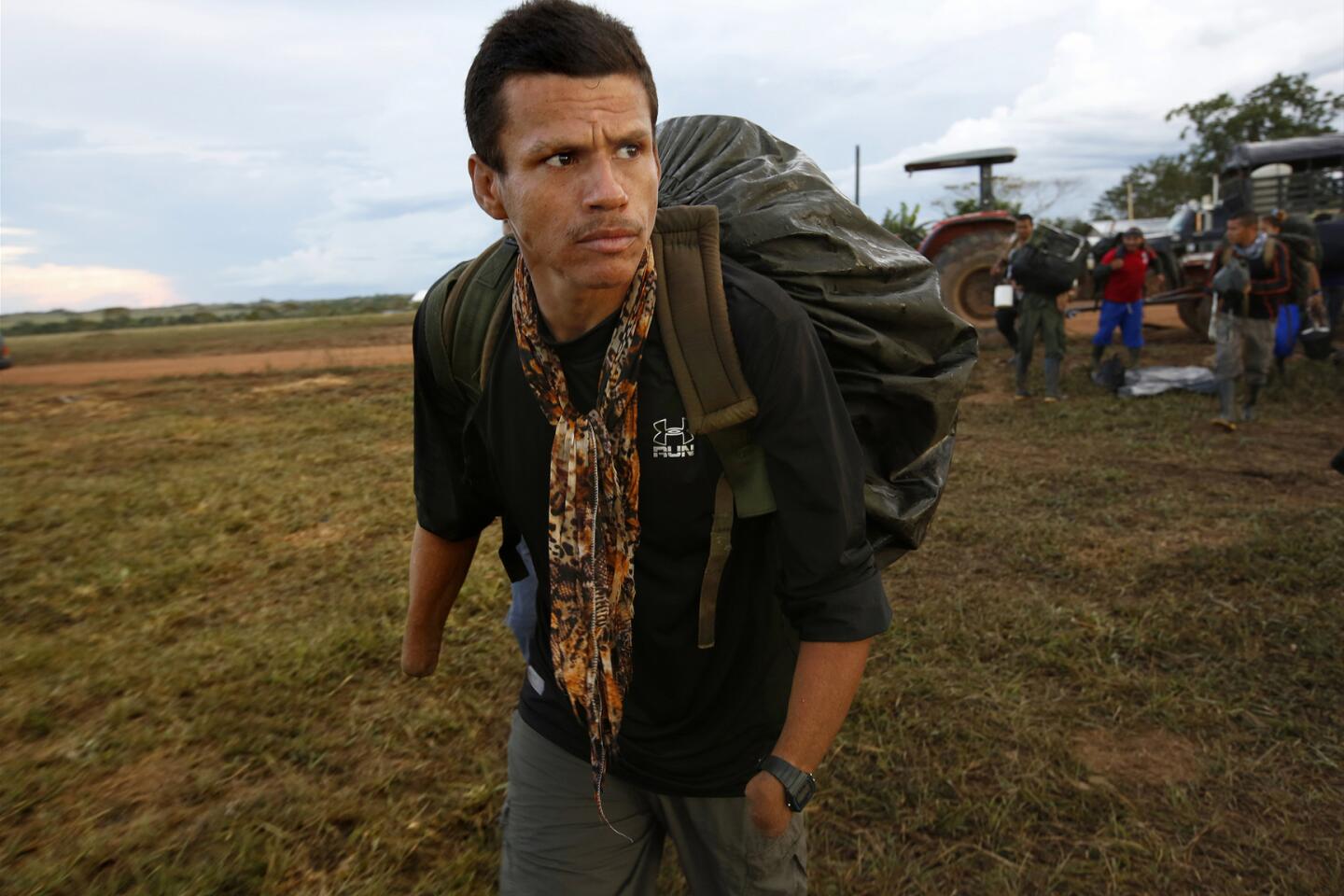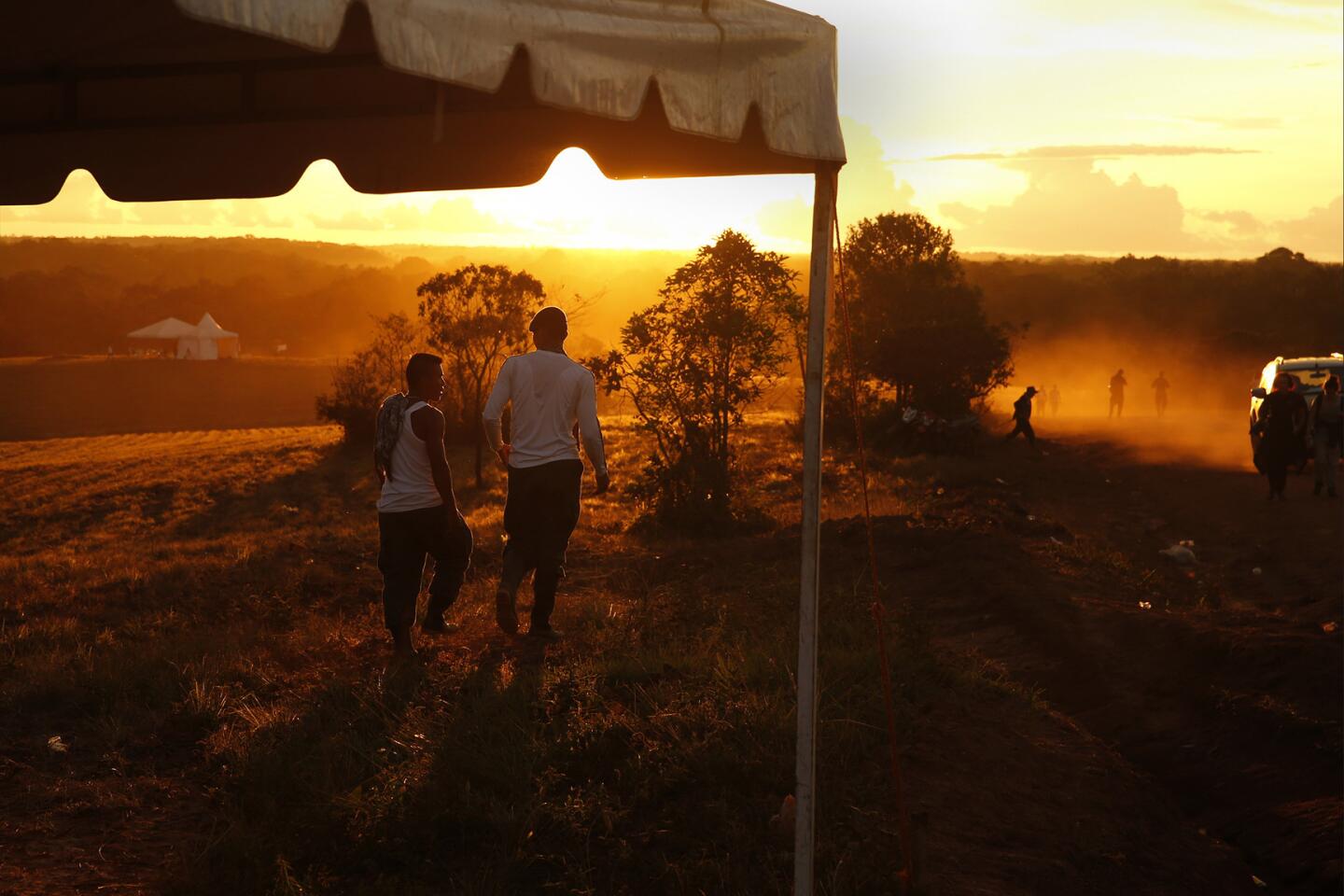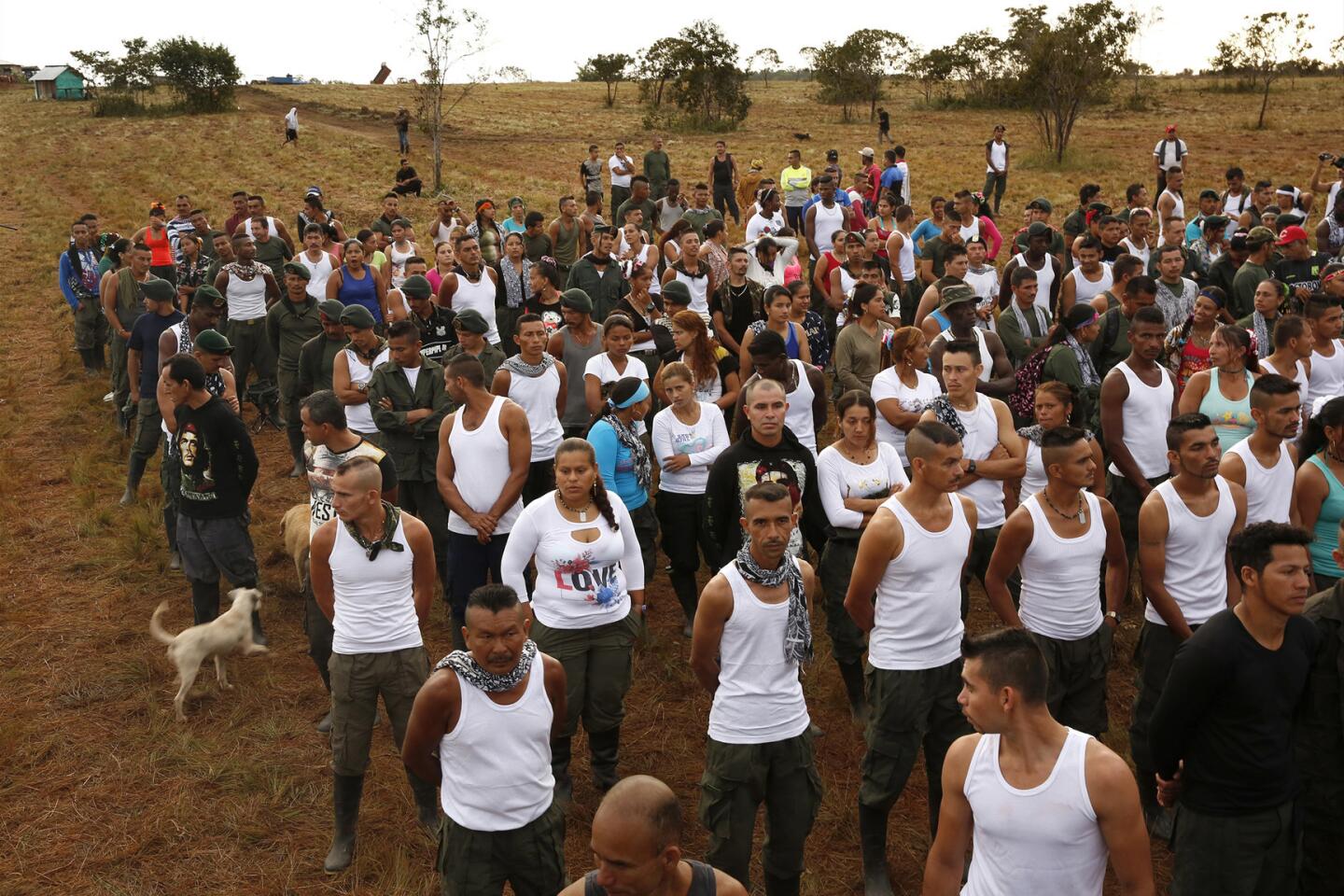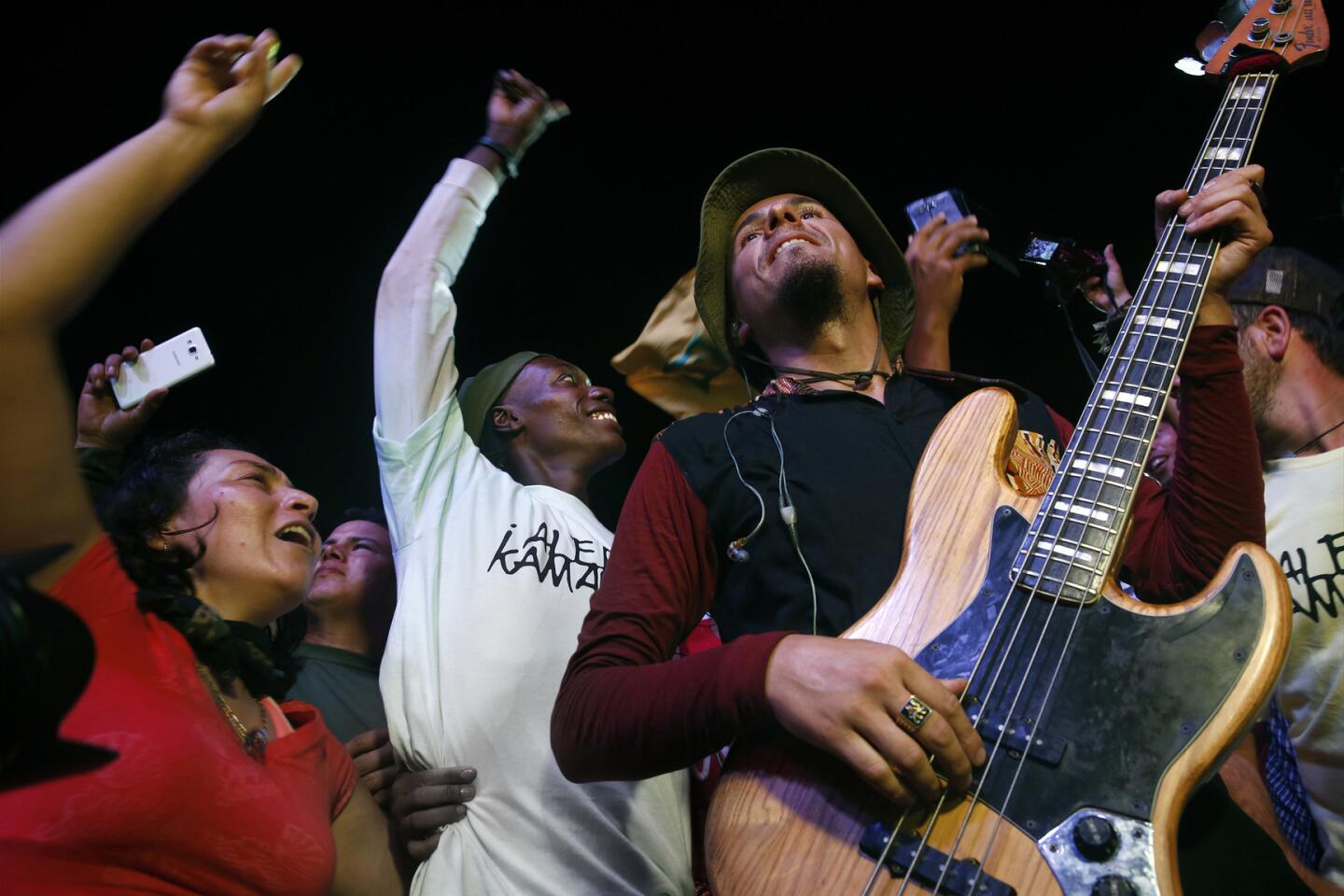After five decades in the jungle, Colombian guerrillas get a PR makeover as they prepare for peace
- Share via
Reporting from Yari Plains, Colombia — After more than five decades of bloody civil war, Colombia’s infamous armed guerrillas were preparing for peace.
Big-name bands from Bogota descended on a remote stretch of rebel-held savanna, where the rebels had erected a Coachella-sized stage. Hundreds of arriving journalists were greeted not with rifles drawn, but by a public relations team of smiling female guerrillas. Instead of combat fatigues, they wore linen blouses. Instead of guns, they carried MacBooks.
The Revolutionary Armed Forces of Colombia, better known as the FARC, is re-branding.
On Monday its leaders are scheduled to sign a historic peace agreement, under which an estimated 7,000 peasant fighters would give up their weapons and restart life as civilians. The FARC gathering earlier this month — seven days on rebel-held territory in the lush Yari Plains — was a chance for the group to plot its political future and unveil a kinder public face.
The conference, held with logistical support from the Colombian government, was at times a raucous celebration of the prospect of peace, with epic nightly concerts for guerrillas who have spent years in the jungle far from civilization and who have lost limbs, lovers and friends over decades of war.
It was also a time of intense emotion as some of them reunited with long-separated relatives, and others contemplated their transition back into the workforce and families and homes.
And it was calculated media event, with news conferences twice a day, expansive dormitories for journalists and an intermittent Internet signal provided by a company called Amazon Connections.

FARC leaders are scheduled to sign a historic peace agreement, under which an estimated 7,000 peasant fighters would give up their weapons and restart life as Colombian civilians.
Each day, while rebel leaders met privately, a group of specially chosen young guerrillas gave interviews and posed for photographs while bathing in shady rivers and resting in small wooden huts.
“We want you to know the truth,” said a 30-year-old fighter named Andres, who joined the group four years ago, and who like many guerrillas would give only his wartime moniker and no last name. “Other people have painted us badly. There’s a good part of Colombia that doesn’t understand who we are and why we’ve been fighting.”
There’s no question that the FARC’s image is in need of a makeover.
The peace agreement announced in Havana last month calls for a six-month disarmament process as the rebel group seeks to reinvent itself as a far-left political party. But winning elections requires popular support, and many war-wary Colombians associate the FARC with kidnappings, disappearances and other aspects of a violent epoch they would like to move past.
And there is a more pressing concern: The peace deal is contingent on approval in a countrywide plebiscite Oct. 2. While the latest polls show a majority of Colombians support the deal, popular ex-President Alvaro Uribe is mounting an aggressive campaign to kill it.
Uribe and others argue that the guerrillas do not deserve forgiveness, and question whether the militants are sincere about their plans to give up the extortion schemes and involvement in the cocaine trade that is rumored to have made some of their leaders rich.
The guerrillas say they are committed to the terms of the peace agreement as long as the Colombian government follows through with its promise of amnesty for all except those accused of war crimes.
According to the peace deal, demobilized guerrillas will be eligible for a monthly government stipend for two years as well as one-time cash payments of more than $2,000 to start businesses.
The FARC says some former fighters may continuing living together in small rural collectives to organize political campaigns. Others may leave the jungle and their comrades to enroll in school, have children, or return to families they haven’t seen or spoken to in years.
Reunions will not be easy. The conflict sometimes pitted guerrillas against their own relatives, with rebel leaders instructing young fighters to forget blood ties and be prepared to kill.
“They haven’t heard from me in many years,” Andres said of his family. “My mother probably thinks I’m dead.”
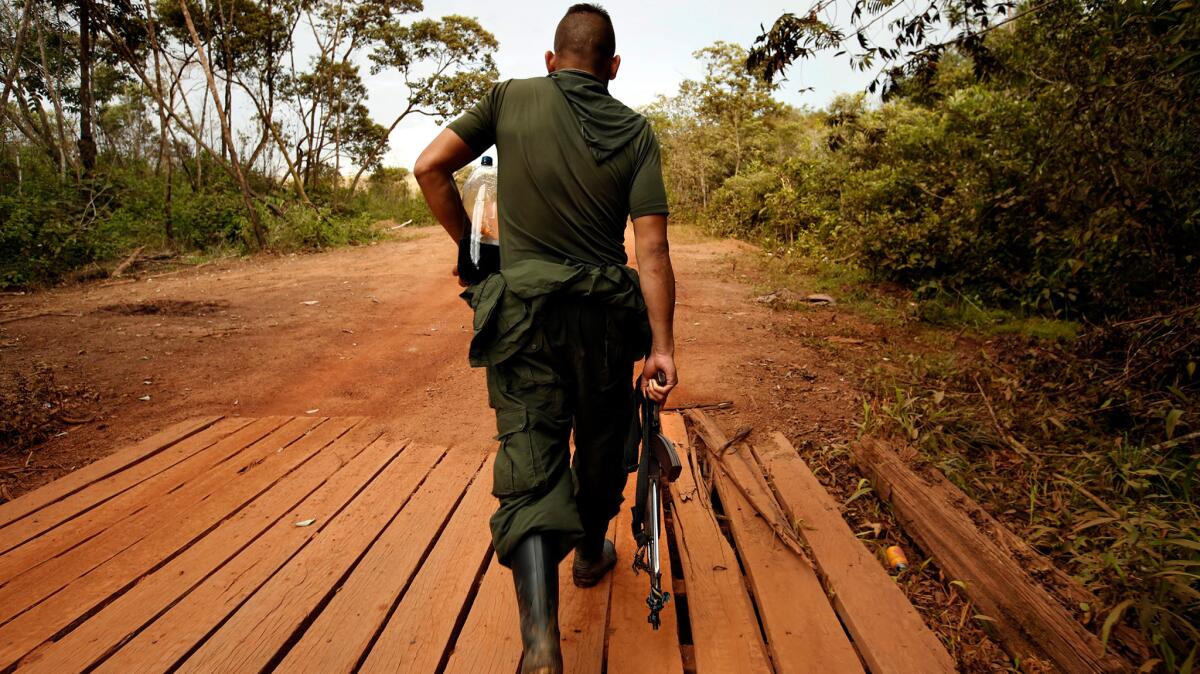
Wandering the rambling conference site were mothers looking for their sons who had joined the group. There was also at least one son who came looking for his mother, a 36-year-old guerrilla named Tatiyana.
She left him to be raised by her brother shortly after birth. The FARC discouraged its members from having children.
Now 16, the boy arrived with his uncle, who saw the conference as a safe opportunity for him to meet his mother.
Hours after the boy left to return home, Tatiyana was still quivering. “Difficult doesn’t begin to describe it,” she said. “He is young and still doesn’t understand why I did what I did.”
::
The FARC was founded in 1964 when bands of peasants calling for land redistribution took up arms against the government. The group’s strongest days were the late 1990s, when profits from drug trafficking and kidnapping ransoms allowed it to expand its control in the countryside.
In 2002, Uribe launched an offensive, backed by the United States and aided by conservative paramilitary groups, that killed many leaders of the FARC and thinned its ranks. Up until the peace talks began in Havana four years ago, the guerrillas spent much of life on the run, dodging airstrikes and sometimes changing encampments every few days.
The peasants whom the guerrillas claimed to be defending were often caught in the crossfire. In all, nearly a quarter million Colombians were killed. Millions were displaced, and tens of thousands more disappeared and were never found. Makeshift graves are scattered across the countryside.
Reminders of war cast a shadow on peaceful moments, including a muggy afternoon when several guerrillas blared merengue on an MP3 player and stripped down to their underwear to bathe.
David, 33, was missing an arm. Jon, 34, had a bullet scar on his left leg.
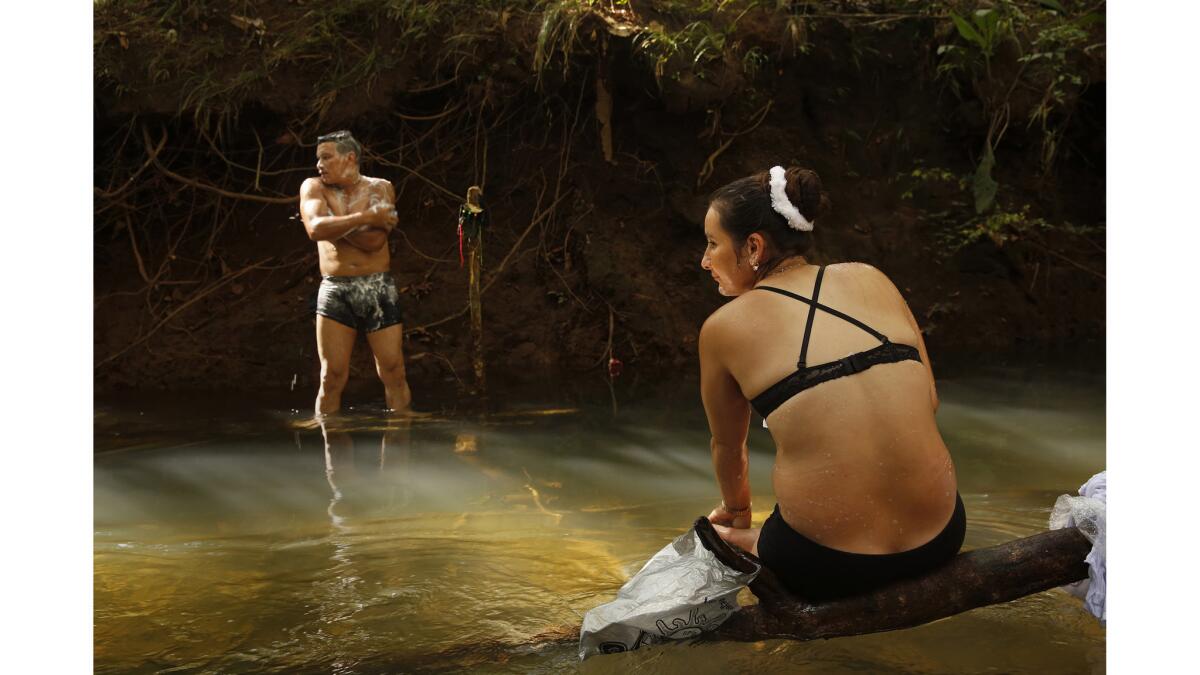
Viviana, 28, was still recovering from a shattered elbow she suffered when paramilitary soldiers attacked her and her boyfriend while they were walking through the jungle a few years ago. The scar looks like a thick spider web. Her boyfriend, who was hit in the leg, nearly died from blood loss.
Viviana was 14 when a paramilitary group formed by wealthy farmers to defend themselves against the FARC pillaged her family’s farm and stole the animals. When several classmates decided to seek vengeance by joining the FARC, she went with them.
Some human rights researchers estimate that as many as a quarter of the FARC’s fighters are younger than 18.
“Guerrilla life is hard on occasion, but it’s also beautiful,” recruiters would tell children to sway them to join.
Viviana said she doesn’t regret her decision. She has gotten used to life in the jungle, where she neatly lines up shampoo, lotion and perfume bottles on the edge of her tree-limb and cardboard bed.
But she is ready for the end of a war that sometimes forced her to fight old classmates from school.
“We’re all kids from the same town, and we’ve been killing each other,” she said.
::
The FARC has tried to enter mainstream politics before, with disastrous results.
In 1984, the group signed a peace deal with the government that led to a three-year cease-fire and the formation of a FARC-allied political party called the Patriotic Union. But the peace agreement broke down when right-wing death squads killed about a thousand of the party’s members, including several congressmen and two presidential candidates.
“Now we are trying again in the name of peace for the Colombian people,” said Emiliano Lemos, 54, a one-time member of the former party who came to the FARC conference to report for an independent radio show he helps run from the United States, where he gained political asylum in the 1990s.
“It’s scary,” Lemos said. “We are scared that the paramilitary groups will take power in the areas where the guerrillas were protecting the people. We are scared we will be killed again.”
But for now, any fears about the future are overshadowed by joy, he said.
“We are finishing with all this,” he said. “This is a celebration in peace that the warriors have never had.”
Transforming the FARC into a viable political force means counteracting years of sophisticated anti-guerrilla messaging by the government.
“It’s not that easy because in Colombia there’s been a war going on for a long time, not only a military war but also a media war,” said Tanja Nijmeijer, a Dutch-born guerrilla who joined the FARC in the early 2000s and is known as Alexandra. “For us it’s going to be difficult to reverse.”
The organization now has YouTube channels and Twitter accounts, in part to appeal to young voters in Colombia’s urban areas, regions far from the group’s traditional rural strongholds.
With its lineup of hip Bogota musical acts and a stage featuring massive screens and laser lights, the conference is the group’s “coming-out party,” said Alex Fattal, an anthropologist who studies the group’s media strategy and teaches at Penn State University.
Or as one of his friends described it, a nod to the AK-47 rifles some guerrillas had slung over their shoulders: “It’s like open-carry Burning Man.”
The nightly concerts drew large crowds of fighters as well as local supporters, some of whom watched the spectacle with cases of Aguila beer from the beds of dusty pickup trucks.
The bands included a cumbia group made up of guerrilla musicians called Rebels of the South, as well as a socially conscious funk band whose lyrics praised recycling and permaculture.
“We want peace, but with social justice,” rapped a FARC member who joined the stage with a reggae band from Bogota called Alerta Kamarada.
Watching the scene, a FARC member, Fabio, shook his head in disbelief. The 50-year-old guerrilla leader said there had always been always a musical component to the group’s conferences in the past. But those were secret meetings, where guerrillas made war plans and went to lengths to avoid detection, and the bands had to play quietly.
The concert made him think of all the people who have died.
Gesturing to the shadows, he said, “It feels like they’re here with me.”
::
With the exception of a small group of FARC fighters in a southern jungle province who have said they won’t give up arms, the organization’s leader reported that the peace deal has the group’s “total” support.
“In this war, there are neither victors nor vanquished,” FARC Commander in Chief Rodrigo Londono, known as Timochenko, told a group of hundreds of guerrillas gathered on the first day of the conference. He had traded his army fatigues and beret for a bright white T-shirt. “Our greatest satisfaction is that we won peace,” he said.
But even with the accord, peace is not guaranteed.
“This only fixes 5% of our problems,” said Mauricio Velez, a photographer who has been documenting the conflict for 18 years. Drug trafficking and organized crime will persist, as will other armed groups, such as the National Liberation Army.
“When they leave, immediately other groups will enter their spaces,” he said.
Velez came to the conference looking for a picture for the last page of a book about the conflict that he is currently editing.
It wasn’t long before he found it. The photograph he snapped was of a young guerrilla, standing alone beneath a giant sky. Behind him, on the horizon, was a bright orange setting sun.
Twitter: @katelinthicum
ALSO
Gabriele Amorth, prominent Roman Catholic exorcist, dies at 91
Money launderer for ‘El Chapo’ gets 8 years in U.S. prison
Fears for Mexico’s economy grow as the peso nears the 20 to the dollar mark
More to Read
Sign up for Essential California
The most important California stories and recommendations in your inbox every morning.
You may occasionally receive promotional content from the Los Angeles Times.
